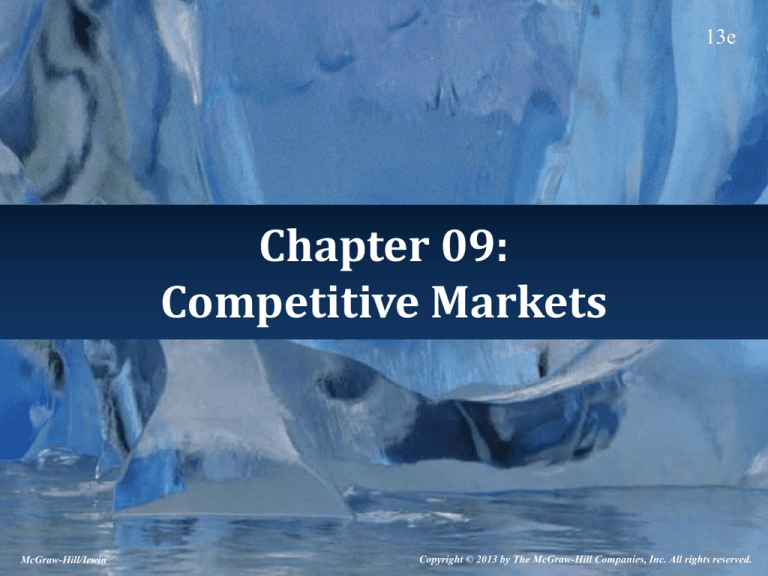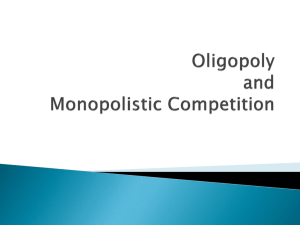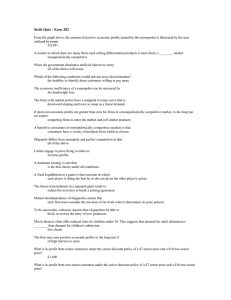
13e
Chapter 09:
Competitive Markets
McGraw-Hill/Irwin
Copyright © 2013 by The McGraw-Hill Companies, Inc. All rights reserved.
Competitive Markets
• If an industry is profitable, it lures in new
firms and existing firms expand. Supply
shifts right.
• This causes price to fall and profits to
decline.
– Some firms, both old and new, fail and close.
9-2
Learning Objectives
• 09-01. Know the market characteristics of
perfect competition.
• 09-02. Know how prices are established in
competitive markets.
• 09-03. Know why long-run economic profits
approach zero in competitive markets.
• 09-04. Know how society benefits from
market competition.
9-3
The Market Supply Curve
• Each firm’s supply curve is its marginal cost
(MC) curve.
• The market supply curve, then, is the sum of
the MC curves of all the firms.
• It is determined by
–
–
–
–
–
The price of factor inputs.
Technology.
Expectations.
Taxes and subsidies.
The number of firms in the industry.
9-4
Entry and Exit
• It is easy to enter or exit an industry in perfect
competition.
– If more firms enter (lured in by economic profits),
the market supply curve shifts right and price falls.
– As price falls, economic profits decrease and
approach zero.
•
•
•
•
Entry will cease.
Some firms could be making losses by this time.
Many will cut back output or exit.
If so, the supply curve shifts back to the left and the price
rises.
9-5
Market Entry
9-6
Market Stabilization
• Economic profits draw in new firms.
– Supply shifts right and prices fall.
– Economic profits decrease, halting new entries.
– The market stabilizes at a lower price, more
producers, and zero economic profits.
• Economic losses drive out firms.
– Supply shifts left and prices rise.
– Economic losses decrease, halting new exits.
– The market stabilizes at a higher price, fewer
producers, and zero economic profits.
9-7
Market Characteristics
of Perfect Competition
•
•
•
•
•
•
Many firms, all small relative to the industry.
Perfect information.
Identical products.
Profit maximized at MC = P (= MR).
Low barriers to entry and exit.
Zero economic profit.
9-8
Competition at Work
• Few, if any, product markets are perfectly
competitive, but many function that way.
• The existence of economic profits in a low
entry barrier market lures in new firms,
which lowers the price of the product.
– Firms compete by improving product quality
and lowering costs.
– Those who cannot compete this way leave the
industry. Others flourish and expand.
9-9
Competition at Work
• Each firm, old and new, in the industry, in the
short run, maximizes profits by setting an
output where MC = P (=MR).
– As price falls, squeezing profit, each firm must
• Reset its profit-maximizing quantity to a smaller amount.
• Compare P to ATC to see if it is making a loss.
• Compare P to AVC to see if it should shut down (exit the
industry).
– Those who are still profitable expand; others leave
the industry.
9-10
Profit Squeeze
9-11
Profit Squeeze
9-12
Short- vs. Long-Run Equilibrium
9-13
Rules for Entry and Exit
• If P > ATC, economic profits exist.
– Enter the industry or expand capacity.
• If P < ATC, economic losses exist.
– Reduce capacity (or exit if P < AVC).
• If P = ATC, economic profits are zero.
– Maintain existing capacity (no entry or exit).
9-14
Lower Costs: Improve Profits and
Stimulate Output
• If a firm lowers its costs
of production, it will
encourage increases in
output.
• The cost curves fall,
and MC appears to shift
right.
• Profit maximization
occurs at point J before
and point N after the
reduced costs take
effect.
9-15
Shutdown
• If competition drives price below AVC for a
firm, it will shut down and exit the industry.
– If the exiting firm has inventory, it will dump
that inventory on the market at a reduced price.
– This will cause the industry price to drop
further, possibly causing losses for other
industry firms.
9-16
The Competitive Process
• Competitive forces drive the product’s price
down, making it more affordable to more
consumers. Thus the market expands.
• Also, competitive forces spur firms to improve
quality, add features, and look for lower costs.
• This is the market mechanism at work.
– Market mechanism: the use of market prices and
sales to signal desired outputs (or resource
allocations).
9-17
The Competitive Process
• If economic profits are high, consumers are
willing to pay more than the opportunity
cost of resources to acquire a product.
– It signals they want more of that industry’s
goods.
– Profit-seeking producers respond by producing
more to satisfy consumer demand.
– This is allocative efficiency: the industry will
end up producing the right output mix.
9-18
The Competitive Process
• If economic profits are negative (losses),
consumers are unwilling to pay the
opportunity cost of resources to acquire a
product.
– It signals they want fewer of that industry’s goods.
– Profit-seeking producers respond by producing less
to satisfy a waning consumer demand.
– This is also allocative efficiency: the industry will
end up producing the right output mix.
9-19
Zero Economic Profit
• Competition drives costs to minimum ATC, and
economic profits to zero.
– The HOW question is answered: produce at
maximum efficiency.
• Firms earn zero economic profit. However, this
means they are earning normal profit, which
covers the opportunity cost of owners who
could deploy their resources elsewhere.
9-20
Relentless Profit Squeeze
• High price and profits signal consumers’
demand for more output.
• Economic profit attracts new suppliers.
• The market supply curve shifts right, and the
price falls.
• The market stabilizes at higher output, lower
price, minimum ATC, and economic profit at
zero.
• All this time, producers must improve their
product and innovate technologically to remain
competitive.
9-21
Summary of Competitive Process
9-22





